
 |
Home | Makalu Main | Contact |
Updated: October 2011. Click on an image to see the FULL size with a caption.
The following reference information is included:
My rating scale:
 Excellent ;
Excellent ;
 Very Good ;
Very Good ;
 Good ;
Good ;
 Fair ;
Fair ;
 Poor.
Poor.

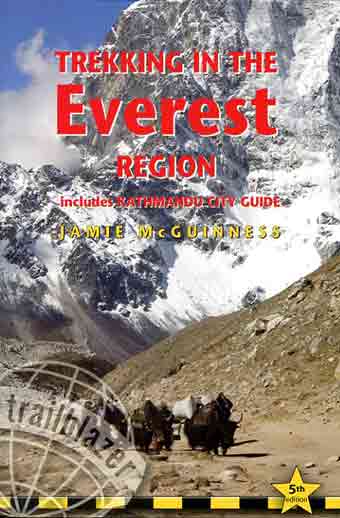

by Stan Armington. A classic trekking book detailing with good maps and route descriptions all of the favourite Nepalese treks, including Gokyo and Everest, Annapurna, Kangchenjunga, Annapurna, Mustang, and Makalu.

by Jamie McGuinness. Highly Recommended! This is the best trekking book I have ever used. The maps are especially detailed and accurate. It includes five pages on the trek to Makalu Base Camp.
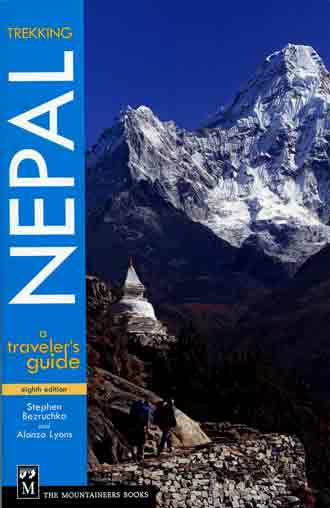

by Stephen Bezruchka and Alonzo Lyons. This book contains detailed route descriptions of the Annapurna Sanctuary and Circuit, Gokyo and Everest, Makalu, Langtang, Gosainkund, Helambu, and some rare treks like Rara Lake. There are only a few maps that are basic overviews and not detailed. There are 16 pages of colour photos and many b/w photos.

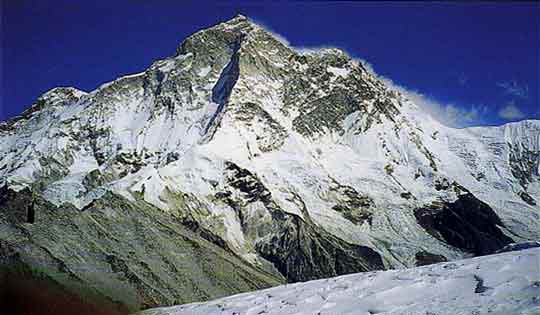

by Steve Razzetti. This book contains basic information on 25 treks in Nepal, including Humla to Mount Kailash, the Annapurna Sanctuary and Circuit, the Dhaulagiri Circuit, Jomsom to Mustang, Around Manaslu, Rolwaling, Gokyo and Everest, Makalu, and Kangchenjunga. It also contains descriptions of climbing 12 trekking peaks, including Pisang, Chulu, Ramdung, Lobuche East, Imja Tse, and Mera. The front cover is Annapurna South.
The book includes three pages on Tumlingtar to Makalu, and two pages on the Three Cols from Chukung to Makalu.
The trekking route descriptions and maps are basic. The photos are very good.
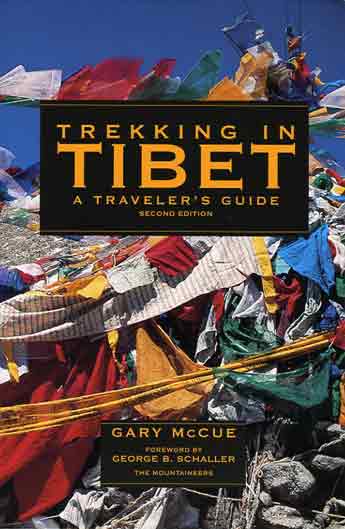


by Gary McCue. Highly recommended! An excellent book detailing the popular treks like Everest North Base Camp and Kailash Kora, and less common treks like Everest North Advanced Base Camp, Everest East Kangshung Base Camp, Shishapangma South and North Base Camps, Cho Oyu Advanced Base Camp, and Menlungtse. The Everest East Kangshung Base Camp trek passes to the north of Makalu and Chomolonzo.

by Victor Chan. Over a thousand pages, extremely detailed travel and pilgrimage guide. Includes a description of the Everest East Kangshung trek, which passes to the north of Makalu and Chomolonzo. The book has good maps.
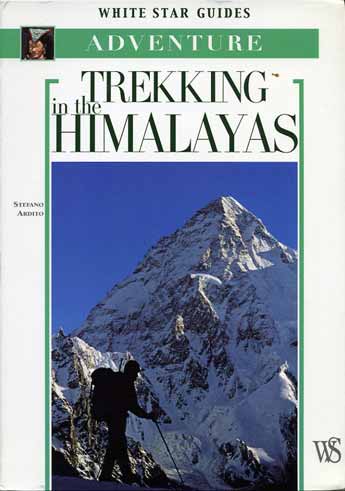
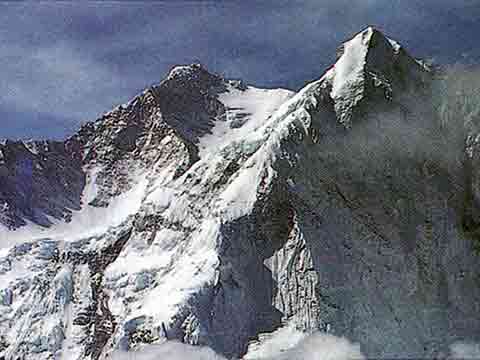

by Stefano Ardito. Good overview maps and photos along with basic descriptions of 15 treks, including four pages on Everest East Kangshung Base Camp, which passes to the north of Makalu and Chomolonzo.

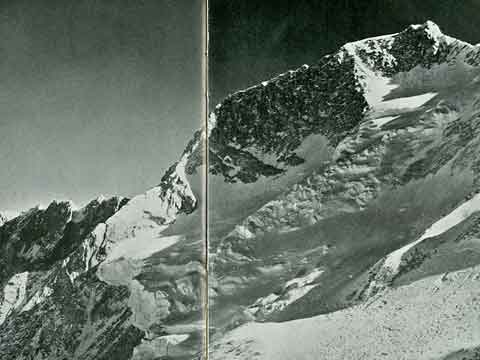
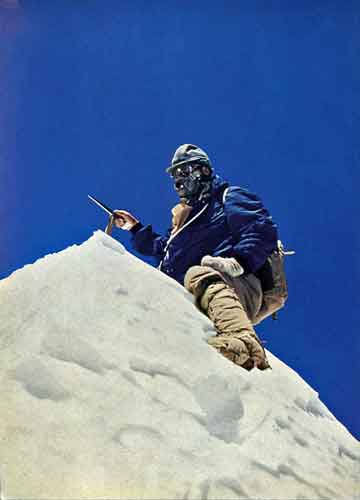

by Jean Franco. Published in French in 1955. The French expedition leader tells the story of the first ascent of Makalu, which succeeded in placing all members on the summit over the course of three ascents. The book I have is in French because the English book is extremely expensive. The 8 pages of colour photos, 32 pages of b/w photos, and 5 maps make the story accessible for non-French readers.
Makalu was first climbed on May 15, 1955 by Lionel Terray and Jean Couzy via the North Col. The next day Franco, Guido Magnone and Sirdar Gyaltsen Norbu reached the summit, followed by Jean Bouvier, Serge Coupe, Pierre Leroux and Andre Vialatte on the May 17.

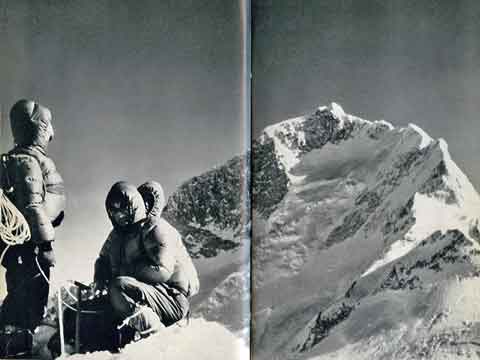
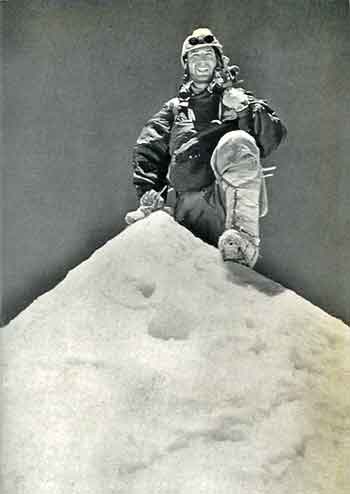

by Lionel Terray. First published in English in 1963. One of Michael Chessler's Top 100 Mountaineering Books. An autobiography focusing on the second ascent of the Eiger North Face in 1947 - returning in 1957 to take part in a dramatic rescue, and participating in the first ascent of Annapurna in 1950. There are brief stories of many of his climbs, including the Walker Spur of the Grandes Jorasses in 1946, the first ascents of Fitzroy and Huantsan in 1952, the first ascents of Chomolonzo in 1954 and Makalu in 1955. There are 84 pages of b/w photos.
There are 13 pages on Makalu and 8 pages of b/w photos. It starts with the reconnaissance of 1954 when Terray and Jean Couzy made the first ascent of Chomolonzo on October 30 to have a better view of Makalu. The French returned in 1955 with Terray and Couzy making the first ascent of Makalu on May 15, 1955.
I really like the writing style, interesting and to the point.
Makalu is featured only in a few books. Here are my favourites:
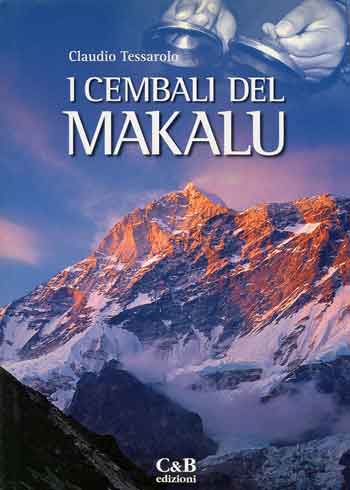

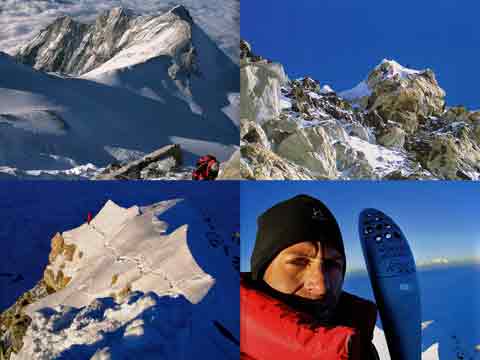

by Claudio Tessarolo. Published 2006 in Italian. This mostly photographic coffee-table book tells the story of a group of Italian mountaineers taking the Torino 2006 Olympic torch bearing a message of peace autographed by the Dalai Lama to the summit of Makalu in 2006. Mario Vielmo said that the main aim of bringing the torch to Makalu was to wish for peace and prosperity in Nepal and to develop brotherhood between Nepal and Italy.
The book starts with a visit to Dharamsala to meet the Dalai Lama who signed the Torino 2006 Olympic torch. They then travelled to Kathmandu, visiting all the major tourist sights including Boudhanath, Swayambhunath, Pashupatinath, Patan, and Bhaktapur.
The team then trekked from Tumlingtar to Makalu Base Camp, with Tom Perry (Antonio Peretti) carrying the Olympic torch all the way barefoot. After the Puja, they did acclimatization climbs, and then prepared for the summit push. Mario Vielma, Renzo Benedetti, Angelo Giovanetti, Daniele Bernasconi, Mario Panzeri, and Temba Wangdi reached the Makalu summit on May 24, 2006.
The photos are excellent. The Kathmandu main sights are all shown. The trek to base camp shows the villages, people, and the terrain. All the key features of the climbing route are illustrated with beautiful photos.
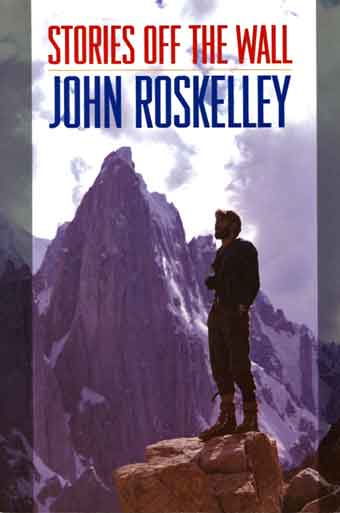

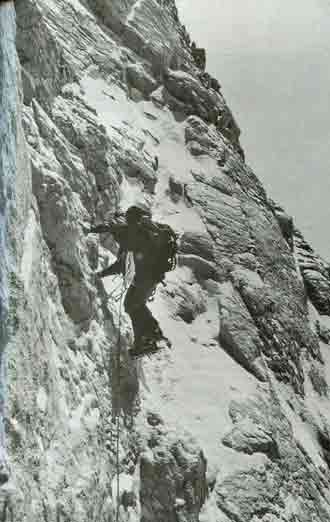

by John Roskelley. First published 1993. An autobiography with brief stories of many of Roskelley's climbs, including Yosemite 1970, Dhaulagiri 1973, the Russian Pamirs 1974, the Eiger 1974, Mount Bourgeau in Banff National Park 1975,Uli Biaho 1979, Makalu West Pillar 1980, Everest West Ridge 1983, and Denali 1992. There are 16 pages of colour photos, 12 pages of b/w photos, and 13 pages with text and b/w photos.
The 16-page chapter on Makalu briefly describes the ascent of Makalu by Roskelley on May 15, 1980 via the West Pillar, on a four-person team in alpine style without oxygen. There are three pages of colour photos, two pages of b/w photos, and one page with text and a b/w photo.
"The West Ridge finally butted into the long knife-bladed Southeast Ridge. After a hundred low-angle yards, we collapsed onto the comparatively wide shoulder before the last obstacle - a five-hundred foot-tall rock and snow summit pyramid." At this point, the others turned around, but Roskelley kept going, soloing this shattered granite wall. "Two steps, then one, and I collapsed to my knees. I was there. The first American to summit 27,800-foor Makalu."
I really like the writing style, honest, humorous and thoughtful.
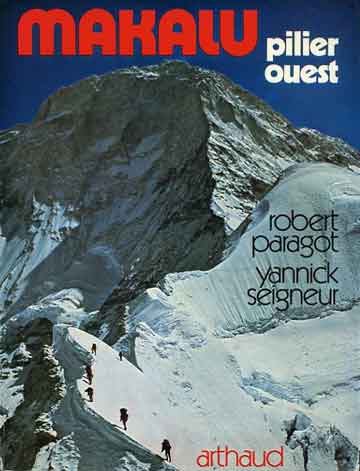
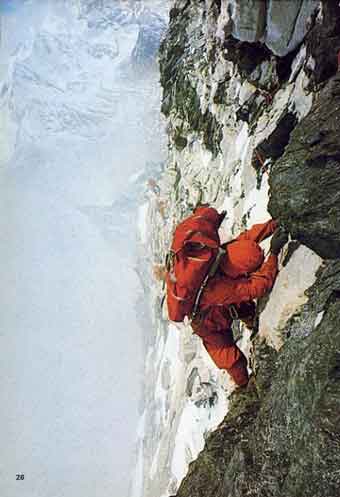
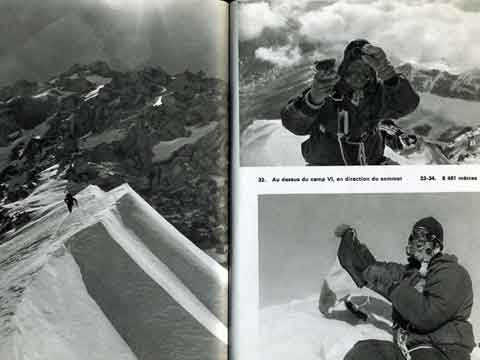

by Robert Paragot and Yannick Seigneur. Published in French in 1972. Makalu stays a French mountain with Robert Paragot leading a team of 11 French mountaineers to attempt the very difficult and technical West Pillar route, which separates the west and south faces and has a near vertical of rock from 7350m to 7700m. The cover is the Makalu West Pillar. There are 16 pages of colour photos, 16 pages of b/w photos, and 4 maps.
After flying to Tumlintar, the team of eleven climbers trek to Base Camp and set up camps. The climbers have to overcome the worst weather of the century with heavy snow, very low temperatures and very high winds. The first two summit attempts failed. Even though his oxygen tank didn't work, Jean-Paul Paris continued from Camp VI at 7770m, but turned around at 8300m.
Robert Paragot from Camp II: "They are at the top! They are at the top! ... On May 23, 1971, at 4 h 15 in the afternoon, Makalu has been defeated by the French." After doing most of the lead climbing, Bernard Mellet and Yannick Seigneur completed the first ascent of Makalu's West Pillar on May 23, 1971. Yannick Seigneur: "Summit. A snowy cone which has already seen the passage of the Franco team in 1955. ... Yes, the summit of the world because, by a strange optical illusion, we feel we can see all the mountains, and Makalu dominates all these mountains"
The photos are very good, bringing the challenges of the ascent to life.
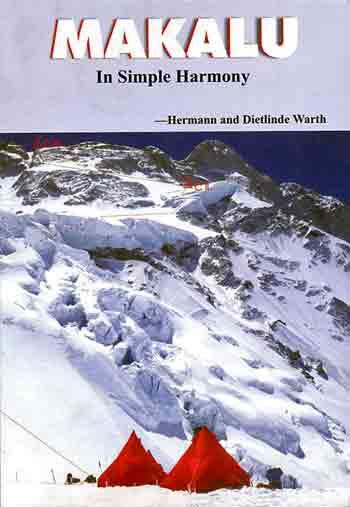
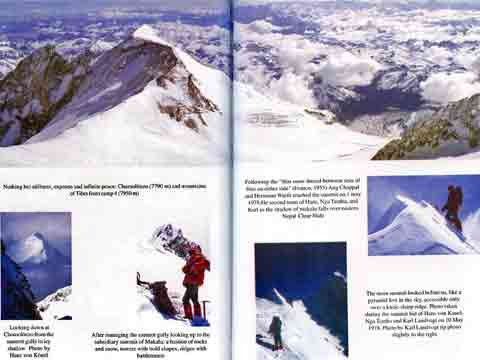
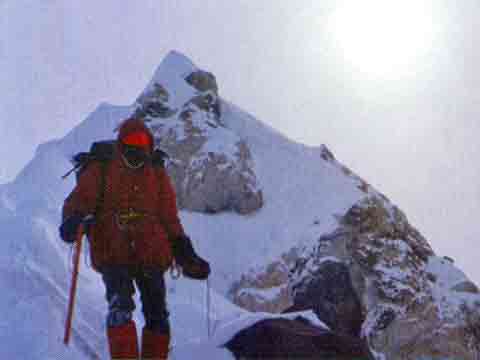

by Hermann and Dierlinde Warth. Published in German in 1980 and in English in 2008. The story of the 1978 International German Nepal Expedition that put all 7 climbing members on the summit. There are 33 pages of photos, most in colour, 8 sketches, 3 maps, and 2 route diagrams.
The book starts in January 1976 with a letter from Kurt Diemberger to Hermann Warth, who was living in Nepal, suggesting an expedition to Makalu "in a real small party". They decided to attempt a traverse of Makalu, climbing the Makalu Southeast Ridge and descending the normal route. In June, the Government of Nepal issued the climbing permit for pre-monsoon 1978. Hermann and Dietlinde put together the small party to include 4 western climbers and 3 Sherpas as full climbing partners. The long march to Makalu starts with a trek from Namche Bazaar to Tumlingtar and then across the snow-laden Shipton La to the Barun Valley. The climbers had to carry their own equipment to base camp when most of their porters quit because of the snow. When they arrived later than planned at Makalu Base Camp South and saw the enormity and difficulty of the Southeast Ridge, they decided to climb the normal route instead.
They continued the trek to Makalu Base Camp North and quickly set up camps I, II, and III. After a rest at Base Camp, Hermann Warth and Ang Chappal climbed past Camp III and set up Camp IV at 7950m. The next day they continue climbing: "Our harmony is something special and makes talk superfluous. ... The summit looms before us, like a pyramid lost in the sky. Less and less contact with this earth. We seem to be climbing up beyond the earth, to be lifting off " On May 1, 1978 Hermann Warth and Ang Chappal reached the Makalu summit.
The small team continues with Ang Chapal climbing once again to camp IV to support the next summit attempt. Hans von Kanel writes, "Slowly, almost reverently, I approach the summit. It is extremely sharp, and i can grasp it with my two hands. ... A warm feeling of happiness flows through my body; ecstatic, I feel as if I were floating in this vast infinitude." Hans von Kanel, Karl Landvogt and Nga Temba reached the Makalu summit on May 10, 1978 at 17:30. They survive a bivouac at 8250m on the descent. Kurt Diemberger was not feeling well, so he trekked back down the Barun Valley to rest and recuperate for his summit attempt. Hermann, Ang Chappal, and Nga Temba climbed once again to Camp IV in support. On May 21 Kurt Diemberger and Nawang Tensing also reached the summit.
The writing is straightforward but entertaining, never boring. The author's love for Nepal and the Sherpas clearly comes through, treating the Sherpas as equals, as brothers. There appears to be a harmony between the expedition members that is often rare for 8000m peak expeditions. The many photos are very good, bringing the story to life.


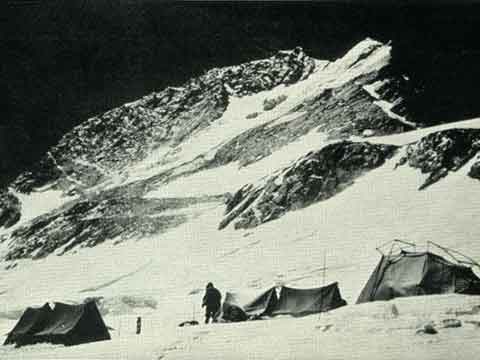

by Peter Mulgrew. Published 1964. The author was a member of the 1960-61 Himalayan Scientific and Mountaineering Expedition, led by Sir Edmund Hillary. The first third of the book tells the story of failing to find the Abominable Snowman, the Yeti, in the Rolwaling and Khumbu valleys. The second third of the book documents the failed attempt without oxygen on Makalu. The last third of the book deals with the author's stays in hospitals in Kathmandu and New Zealand. here are 26 pages of b/w photos.
The 55-page section on Makalu starts straightforward enough, trekking from Ama Dablam across two cols to reach the Barun Valley. They set up camps and get ready for summit attempts. Just over 100m from the summit, the author suffered a pulmonary embolism in his right lung and a full-out rescue started.
"The pain gave no warning. It came like a giant knife, plunged into my right side, without pity and with terrible force, throwing my face down in the soft snow." It took almost two weeks to get down the mountain. "Fortunate indeed is the man who has placed faith, and his life, in the hands of his friends and found them not wanting." Mulgrew suffered severe frostbitten feet during the rescue and suffered amputations. There are 10 pages of colour photos of Makalu.
I liked the writing style, direct, honest, and thoughtful. The photos are very good.
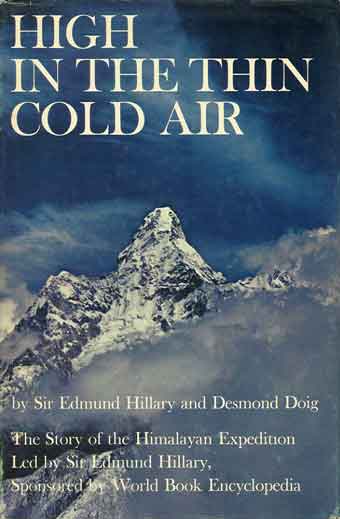

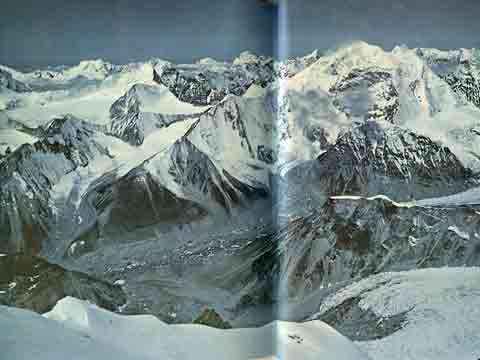

by Sir Edmund Hillary and Desmond Doig. Published 1962. The authors detail the 1960-61 Himalayan Scientific and Mountaineering Expedition. In the first half of the book, Desmond Doig tells the story of failing to find the Abominable Snowman, the Yeti, in the Rolwaling and Khumbu valleys. In the second half Hillary documents the tests on the effects of high altitude as climbers stay at over 5000m on the Mingo Glacier for the winter. Mike Gill, Wally Romanes, Barry Bishop, and Michael Ward made the first ascent of Ama Dablam on March 13, 1961. The books ends with a failed attempt without oxygen on Makalu. There are 35 pages of colour photos and 6 pages of b/w photos.
The 42-page section on Makalu starts straightforward enough, trekking from Ama Dablam across two cols to reach the Barun Valley. They set up camps and get ready for summit attempts. Just over 100m from the summit, Peter Mulgrew suffered a pulmonary embolism in his right lung and a full-out rescue starts. "He was in severe pain and was blacking out, completely unaware of what was happening." It took almost two weeks to get down the mountain. Mulgrew suffered severe frostbitten feet during the rescue and suffered amputations. There are 5 pages of colour photos of Makalu.
I enjoyed reading the tale of adventure, learning, discovery, and challenge. The photos are good.
Makalu is also featured in many general mountaineering books. Here are my favourites:

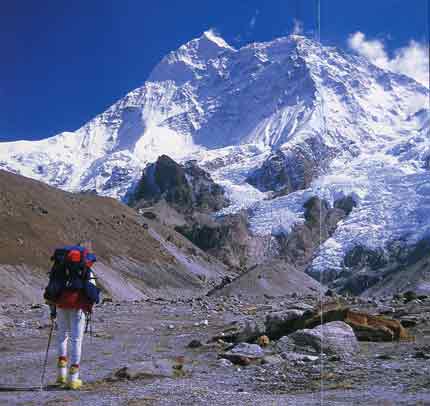


by Richard Sale, John Cleare (Photographer). Published 2000. Highly recommended! The book details the exploration, first ascent, and other major ascents of all 14 8000m peaks, including spectacular photos.
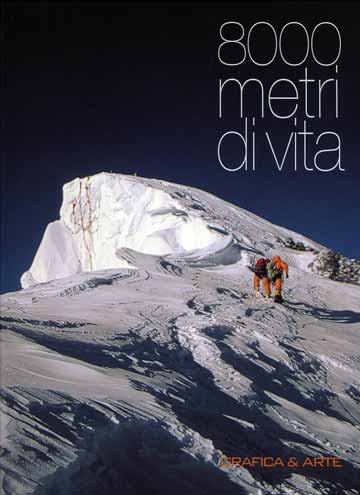
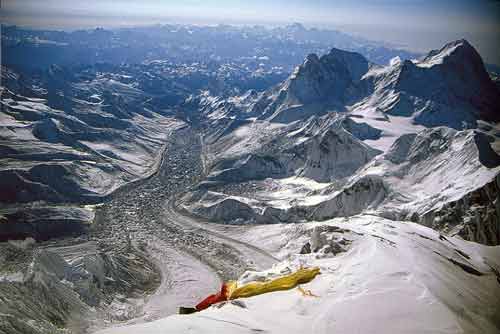
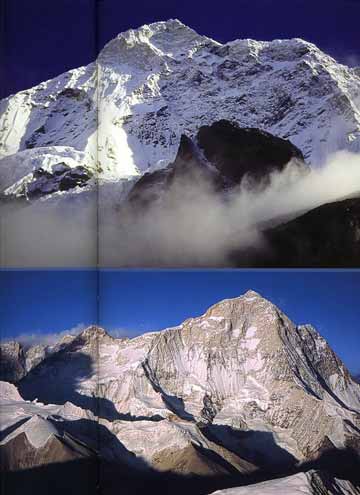

by Simone Moro. Published 2008. In Italian and English. This coffee-table size book features excellent photos from all 14 8000m peaks. Each 8000m peak has a brief history, a photo of each face showing the climbing routes, and lots of excellent photos.
There are 10 pages on Makalu. Simone Moro's solo attempt on Makalu in 1993 ended at 8300m, just 163m short of the summit.
The photos and route diagrams are excellent.

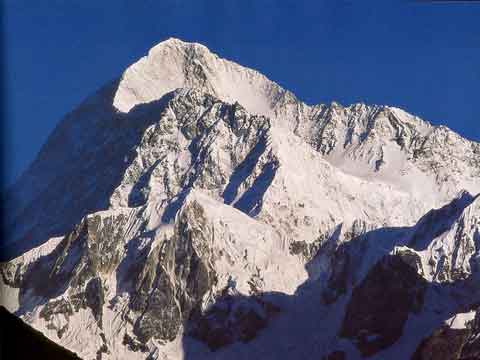
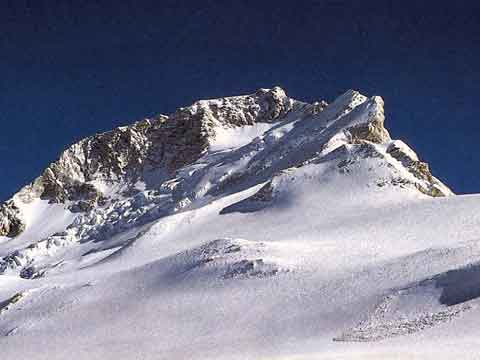

by Doug Scott. First published 1992. One of Michael Chessler's Top Mountain Photo Books. This book briefly details Doug Scott's many climbs over the years, including very good photos.
There are sixteen pages describing his 1980 and 1984 attempts on the Makalu South-East Ridge. In 1980 they reached 8180m when Georges Bettembourg became ill. In 1984 they reached 8370m before Jean Afanassieff called a retreat.


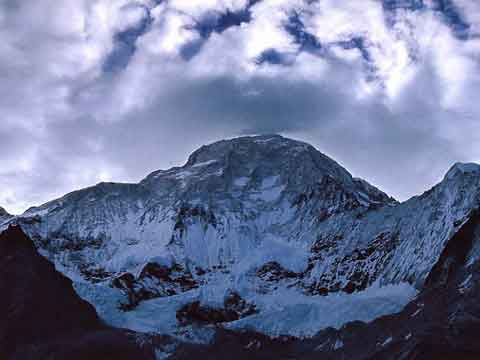

by Marco Bianchi. Published 2003. Although the title claims to be the 14 highest summits in the world, this beautiful, large-format photo book really focuses on the seven mountains the author climbed. The text is in Spanish, but the photos transcend language.
After attempts on Makalu in 1986 and Cho Oyu in 1989, Bianchi summitted seven of the 14 8000m peaks: Manaslu Sept. 28 1992 via Northeast Face, Broad Peak July 6 1993 via Normal route, Cho Oyu Sept. 18 1993 via West Ridge, Shishapangma Oct. 6 1993 via Southwest Face, Dhaulagiri Sept. 25 1994 via Northeast Ridge, Everest May 12 1995 via Northeast Ridge, and K2 Aug. 10 1996 via North Ridge. The front cover is Shishapangma.
There are some pages of the approach, and 14 pages on Makalu from his attempt in 1986. The photos are excellent.
You can preview many of the photos at cuboimages.it by searching for Makalu.

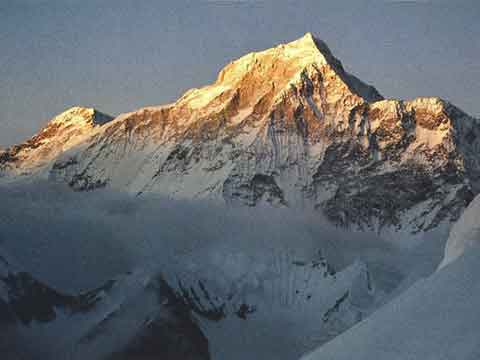
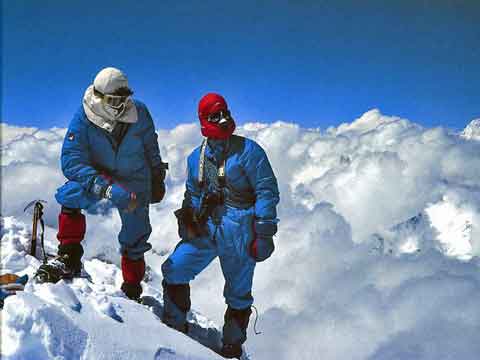

by Reinhold Messner. One of Michael Chessler's Top 100 Mountaineering Books. This book details Messner's ascents of all 14 8000m peaks documented with his photos. He also includes route diagrams and some basic history of the first few ascents. Messner was the first climber to summit all 14 mountains over 8000 metres in height, beginning with Nanga Parbat on June 27, 1970 and finishing with Lhotse on October 16, 1986. The cover photo is on the ascent of Kangchenjunga. The inside title page is on the summit of Nanga Parbat.
On September 16, 1986 Messner, Hans Kammerlander and Friedl Mutschlechner completed the seventeenth ascent of Makalu.
The photos are very good.

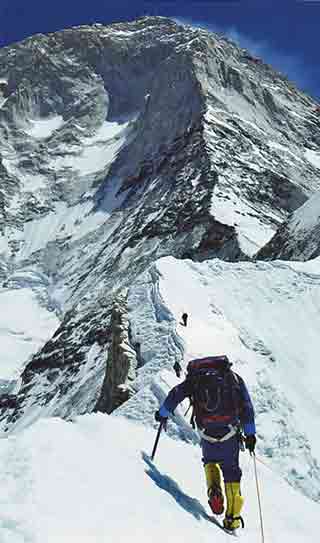

by Andy Fanshawe, Stephen Venables. Published 1996. This book briefly details 40 of the world's finest climbs on mountains in Pakistan, India, Nepal and Tibet. Each climb is illustrated with many great photos, climbing routes, and summary statistics and information. Each area has an excellent overview map. The front cover is Kangchenjunga.
There are 6 pages on Makalu South Pillar.
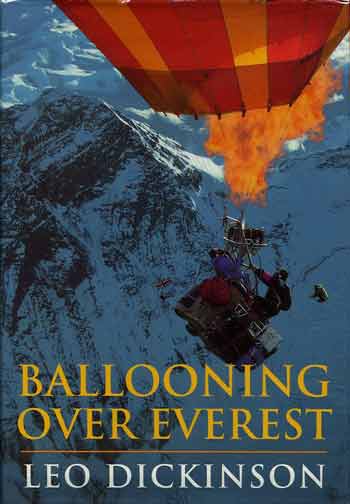
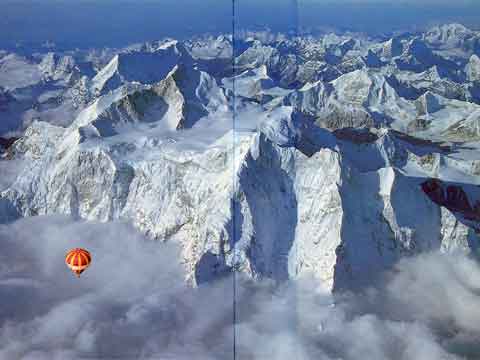
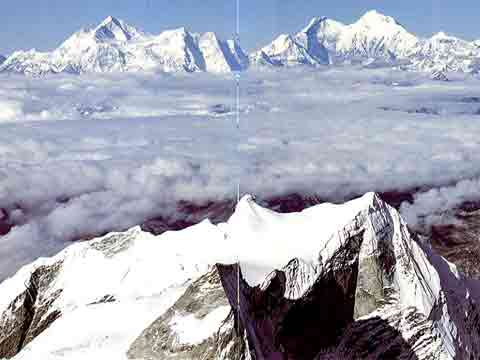

by Leo Dickinson. Published 1993. Also available as a video, this book tells the story of the author's quest to be the first person to fly a balloon over Mount Everest. The book starts with getting the expedition financed and then trekking to Gokyo. They wait over three weeks for the right winds, and then the two balloons took off from Gokyo on October 21, 1991.
"Peter became quite emotional and shed a tear or two. ... May you fly so high and so well, that God will join you in your laughter and set you gently back in the loving arms of mother earth."
Leo Dickinson was in the first balloon, and everything went well until the end, when they crash landed in Tibet, spinning violently. The second balloon got in terrible early when their burners failed several times as they flew towards the Western Cwm. They managed to relight them each time and landed safely in Tibet.
The photos of Everest, Lhotse, Nuptse, Cho Oyu and Makalu are sensational, taken from an overhead angle I have not seen before. There are 10 photos containing Makalu.
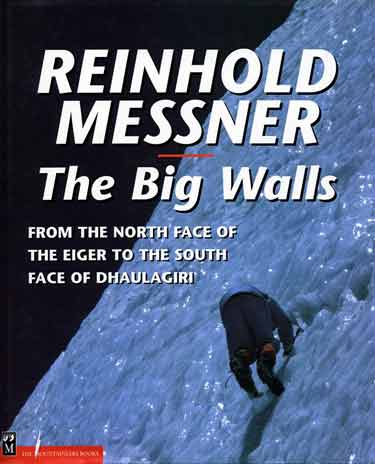



by Reinhold Messner. Published 2001. This book briefly details the big mountain walls in the world in the Himalayas, the Karakorum, the Alps, South America, Alaska and the Caucasus.
It includes a special two-page section on the first ascent of the South Face of Makalu in 1975 and two pages on climbing Makalu South Face, two pages on climbing Makalu West Face, and two additional photos.

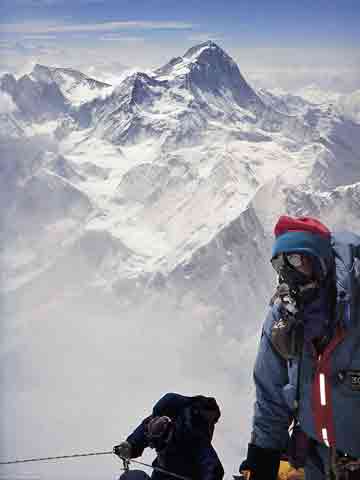
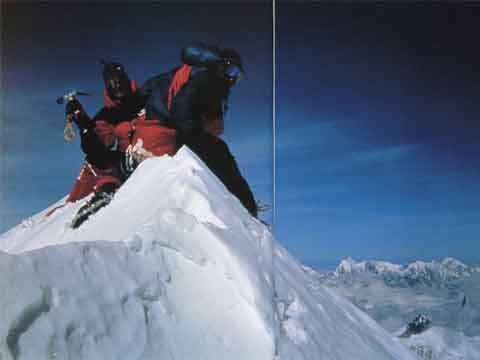

photographs by Ed Viesturs, text with Peter Potterfield. Released in early 2003, this book presents photographs with some basic text descriptions of Viestur's ascents of 11 of the 14 8000ers. After this book was published he reached the summit of Nanga Parbat in June 2003, Broad Peak in July 2003, and on May 12, 2005 he reached the summit of Annapurna, becoming the first American to reach the summit of all 14 8000ers, all without oxygen. The front cover is Manaslu.
Viesturs, Veikka Gustafsson, and Rob Hall reached the summit of Makalu via the North Col on May 18, 1995. There are 11 pages on Makalu. "Shortly after this Rob Hall joined us on the summit. Then there were three of us sitting there like three kids astride a big horse, our feet draped over each side."
Ed's photos are excellent.
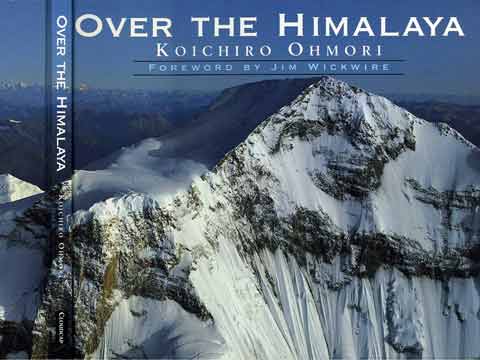
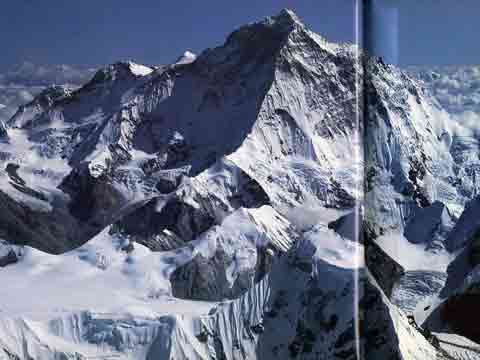

by Koichiro Ohmori. Published 1994. One of Michael Chessler's Best Mountain Photo Books. This book contains 44 spectacular 2-page aerial photos of the 8000m Nepalese mountains - Kangchenjunga, Makalu, Everest and Lhotse, Cho Oyu, Manaslu, Annapurna and Dhaulagiri (cover) - and several others, including Jannu, Nuptse, and Ama Dablam. Route diagrams and some basic history of the first few ascents are also included.
There are seven 2-page photos of the Everest, Lhotse and Makalu region - Everest is in 6 of the photos, Lhotse in 5, Makalu in 5, and Nuptse in 3.

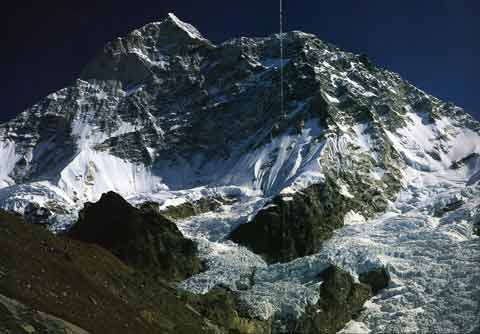
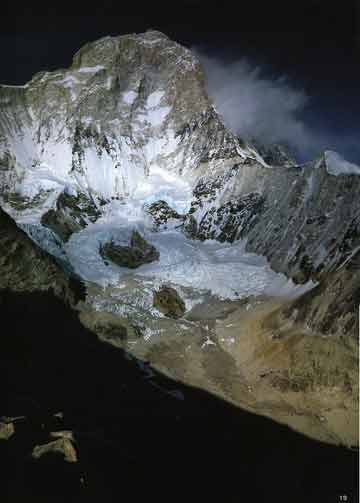

by Shiro Shirahata. Published 1983. One of Michael Chessler's Top Mountain Photo Books. A large, heavy quality paper, coffee-table type book featuring 115 spectacular photos, over half double-pages, of the 8000m Nepalese mountains - Kangchenjunga, Makalu, Everest and Lhotse (cover), Cho Oyu, Manaslu, Annapurna, Dhaulagiri - and many others, including Jannu, Nuptse, and Ama Dablam.
There are 15 pages with 9 photos of the Makalu region - two double-page photos and two single-page photos of Makalu's faces. Other photos include Baruntse and Chamlang.

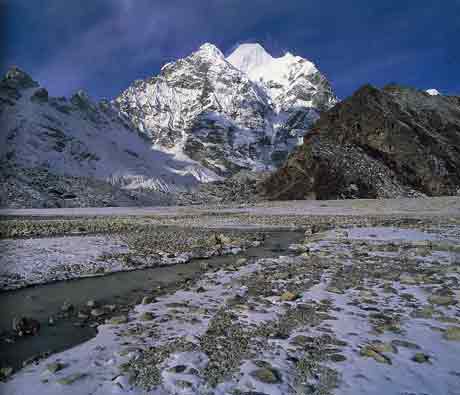
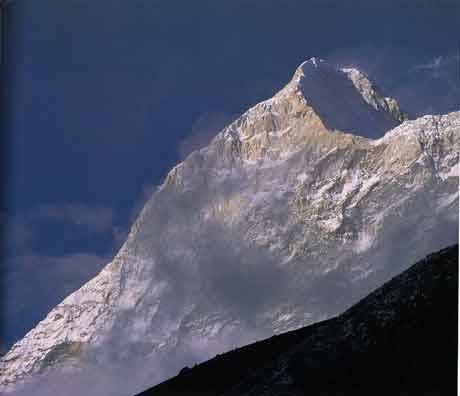

by David Paterson. First published 1990. This large coffee-table photo book features Kathmandu and the author’s treks from Lamosangu to Lobuche Base Camp and Everest in 1979, the Annapurna Sanctuary in 1979, Rolwaling and the Tesi Lapcha pass to Gokyo in 1981, the Annapurna Circuit in 1984, Ganesh Himal in 1987, the Arun Valley from Hille to Makalu in 1988. The front cover is Ama Dablam.
You can see some of David Paterson's photos at his website wildcountry.uk.com.
The photos are very good, especially Makalu and Chamlang from Sherson. These photos are also available in his book Heart Of The Himalaya published 1997.
For news on Everest expeditions, I check the following regularly:
There are many informational websites, with my favourites being:
There are many many trekking websites, with my favourites being:
I thoroughly enjoy reading other people's travelogues and looking through their photos. Here are my favourites:
Here are my favourite Makalu DVDs
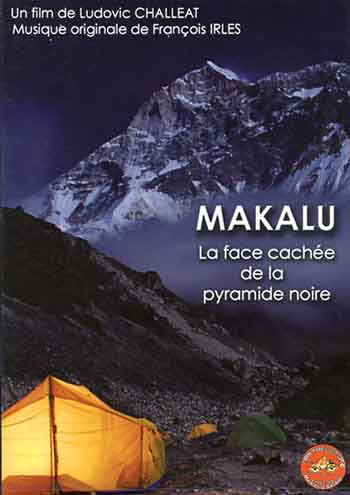
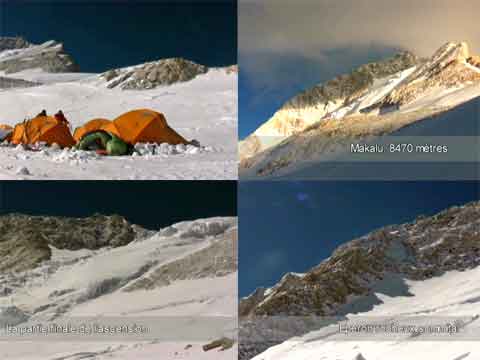
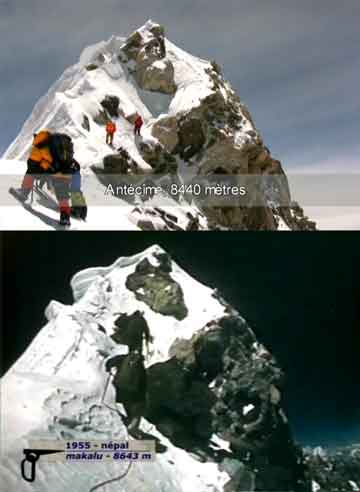
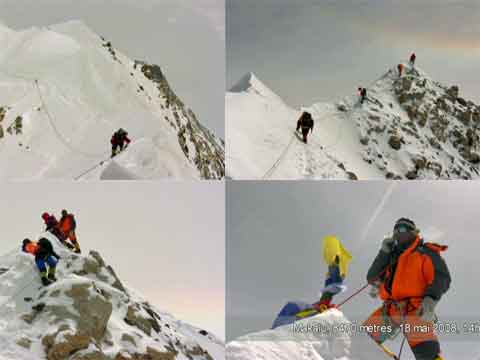

Released 2008. 51 minutes. Directed by Ludovic Challeat. In French. This film follows guide Ludovic Challeat and 9 climbers from Jura, France as they attempt to climb Makalu in the spring of 2008.
The film starts with the trek to base camp, the puja, and the acclimatization climbs to Camps 1 and 2. Interviews with the climbers are interspersed with the climbing footage. After another climb to camps 3 and 4, they descend again to base camp to prepare for the final climb. They get ready to elave at 5am on May 18 with the sun just coming up over Lhotse, Everest, Makalu II, and Chomlonzo.
On May 18, 2008 at 11:00 Ludovic Challeat and Pemba Sherpa reached the summit of Makalu. Jean-Francois Bourgine, Christian Maurel, Jaya Prakash Rai, Phurba Sherpa, and Dorje Sherpa reached the summit at 12:30. Olivier Coudurier and Nil Prasad Gurung reached the top at 14:00. Nil died on the descent at Camp 3.
There are 25 minutes of extras, including television reports featuring interviews and some rare vintage footage of the first ascent of Makalu in 1955, and an interview with Nil Prasad Gurung.
I really enjoyed this film. It is expertly filmed, perfectly paced, and contrasts the climbing with interviews with the climbers. The mountain views are excellent, including Lhotse, Everest, Makalu II, Chomolonzo, and, of course, Makalu. The trek to base camp is short but well documented. The terrain of the climbing route is shown so well it makes me feel like I know the route myself.

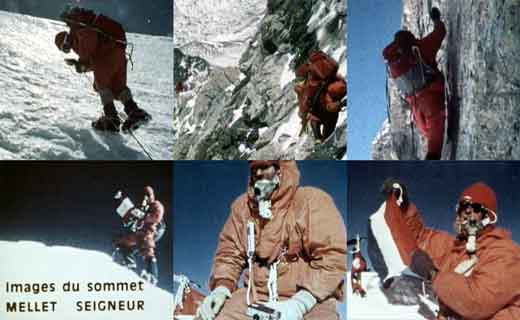


by Sebastian Alvaro. Al Filo De Lo Imposible, Spanish TV 2003. 53 minutes. Filmed in 2002. This film documents the 2002 Spanish Makalu West Pillar Expedition led by Juanito Oiarzabal with climbers Juan Vallejo, Ferran Latorre, Jose Carlos Tamayo, and Josu Bereciartua. This DVD also contains K2 (filmed 1994, 36 minutes). Extras include interviews with Ardito Desio (14 minutes) and Walter Bonatti (17 minutes).
The film opens with the plane landing at Tumlingtar and the trek to South Base Camp with the porters and climbers passing verdant green fields, villages and the local people. A helicopter delivers some of their goods to base camp, and they continue the trek on large rocks to the Makalu West Pillar Base Camp. They climb the snow and ice to set up camps 1 and 2, and descend to base camp, and then climb back up to set up camp 3 (7350m). Ferran Latorre leads the rock pitches above camp 3 as the climbers at base camp watch thru their binoculars. They descend to base camp in snowy conditions and then climb back up to a destroyed camp 3. They dejectedly descend the mountain in bad weather.
Interspersed with the 2002 expedition is a lot of footage from the first ascent of the Makalu West Pillar by the 1971 French Expedition, including the trek to base camp, a flight over the west ridge, the climb and summit footage.
The video quality is very good, and the filming clearly shows the Makalu West Pillar route up to their high point above camp 3. I especially enjoyed the footage from the first ascent in 1971.
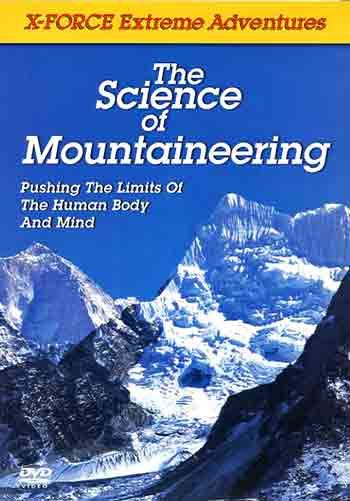
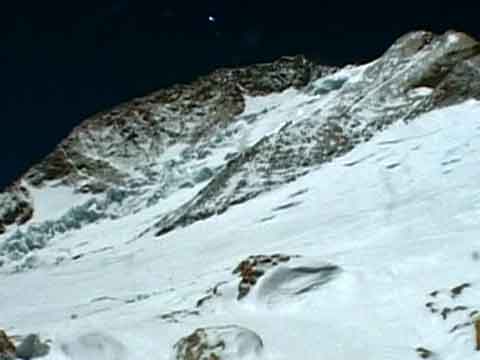
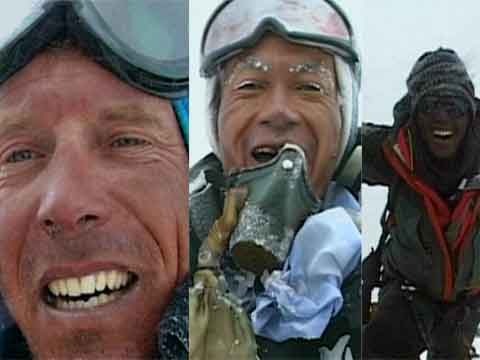

Released 2002. 50 minutes. Directed by Virginia Wright. This film follows Adventure Consultant's Guy Cotter as he leads a team to attempt Makalu, the fifth highest mountain in the world. Expedition leader Guy Cotter (New Zealand) and team members Takashi Ozaki (Japan) and Lhakpa Dorje (Nepal) reached the summit of Makalu on May 12, 2001.
After a brief warm up climb in New Zealand, the film jumps right into the acclimatization climbs to camps 1 and 2, and eventually camp 3 on the Makalu La. There are explanations with graphic displays of what happens to the heart and lungs as the body attempts to deal with the lack of oxygen at high altitude. After regrouping at Base Camp, they leave for the summit attempt, Although Guy is vomiting at Camp 3, he keeps going, while other team members turn back. On summit day, Guy is filming when a small avalanche grabs Takashi, who is able to self-arrest. They continue on to the summit. Guy: "It's so good to be here. Ohhh, man."
This is an action packed film, clearly showing the challenges of climbing at high altitude.